Solar eclipse of September 13, 2015
A partial solar eclipse occurred at the Moon's ascending node of orbit on Sunday, September 13, 2015,[1][2][3] with a magnitude of 0.7875. A solar eclipse occurs when the Moon passes between Earth and the Sun, thereby totally or partly obscuring the image of the Sun for a viewer on Earth. A partial solar eclipse occurs in the polar regions of the Earth when the center of the Moon's shadow misses the Earth.
Images
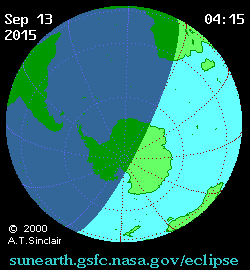 Animated path |  View from center of sun |
Related eclipses
Eclipses of 2015
- A total solar eclipse on March 20.
- A total lunar eclipse on April 4.
- A partial solar eclipse on September 13.
- A total lunar eclipse on September 28.
Metonic
- Preceded by: Solar eclipse of November 25, 2011
- Followed by: Solar eclipse of July 2, 2019
Tzolkinex
- Preceded by: Solar eclipse of August 1, 2008
- Followed by: Solar eclipse of October 25, 2022
Half-Saros
- Preceded by: Lunar eclipse of September 7, 2006
- Followed by: Lunar eclipse of September 18, 2024
Tritos
- Preceded by: Solar eclipse of October 14, 2004
- Followed by: Solar eclipse of August 12, 2026
Solar Saros 125
- Preceded by: Solar eclipse of September 2, 1997
- Followed by: Solar eclipse of September 23, 2033
Inex
- Preceded by: Solar eclipse of October 3, 1986
- Followed by: Solar eclipse of August 23, 2044
Triad
- Preceded by: Solar eclipse of November 12, 1928
- Followed by: Solar eclipse of July 15, 2102
Solar eclipses of 2015–2018
This eclipse is a member of a semester series. An eclipse in a semester series of solar eclipses repeats approximately every 177 days and 4 hours (a semester) at alternating nodes of the Moon's orbit.[4]
| Descending node | Ascending node | |||||
|---|---|---|---|---|---|---|
| Saros | Map | Gamma | Saros | Map | Gamma | |
120 Longyearbyen, Svalbard | 2015 March 20 Total | 0.94536 | 125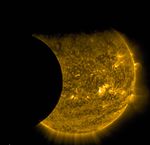 Solar Dynamics Observatory | 2015 September 13  Partial (south) | −1.10039 | |
130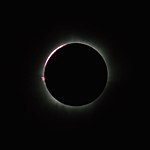 Balikpapan, Indonesia | 2016 March 9 Total | 0.26092 | 135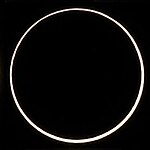 L'Étang-Salé, Réunion | 2016 September 1 Annular | −0.33301 | |
140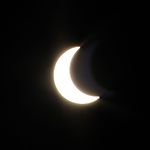 Partial from Buenos Aires | 2017 February 26 Annular | −0.45780 | 145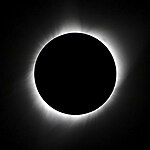 Casper, Wyoming | 2017 August 21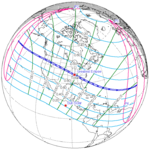 Total | 0.43671 | |
150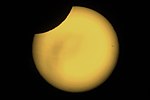 Partial from Olivos, Buenos Aires | 2018 February 15 Partial (south) | −1.21163 | 155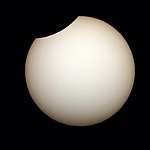 Partial from Huittinen, Finland | 2018 August 11 Partial (north) | 1.14758 | |
Partial solar eclipses on July 13, 2018, and January 6, 2019, occur during the next semester series.
Saros 125
It is a part of Saros cycle 125, repeating every 18 years, 11 days, containing 73 events. The series started with a partial solar eclipse on February 4, 1060. It contains total eclipses from June 13, 1276 through July 16, 1330, hybrid eclipses on July 26, 1348 and August 7, 1366, and annular eclipses from August 17, 1384 through August 22, 1979. The series ends at member 73 as a partial eclipse on April 9, 2358. The longest duration of totality was 1 minutes, 11 seconds on June 25, 1294, and the longest duration of annularity was 7 minutes, 23 seconds on July 10, 1907.
| Series members 48–64 occur between 1900 and 2200: | ||
|---|---|---|
| 48 | 49 | 50 |
 July 10, 1907 |  July 20, 1925 |  August 1, 1943 |
| 51 | 52 | 53 |
 August 11, 1961 |  August 22, 1979 |  September 2, 1997 |
| 54 | 55 | 56 |
 September 13, 2015 |  September 23, 2033 | 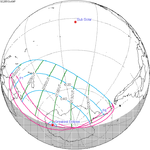 October 4, 2051 |
| 57 | 58 | 59 |
 October 15, 2069 | 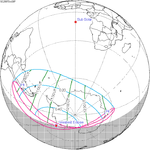 October 26, 2087 |  November 6, 2105 |
| 60 | 61 | 62 |
 November 18, 2123 |  November 28, 2141 |  December 9, 2159 |
| 63 | 64 | |
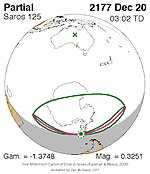 December 20, 2177 |  December 31, 2195 | |
Metonic series
The metonic series repeats eclipses every 19 years (6939.69 days), lasting about 5 cycles. Eclipses occur in nearly the same calendar date. In addition, the octon subseries repeats 1/5 of that or every 3.8 years (1387.94 days). All eclipses in this table occur at the Moon's ascending node.
| 21 eclipse events, progressing from south to north between July 1, 2000 and July 1, 2076 | ||||
|---|---|---|---|---|
| July 1–2 | April 19–20 | February 5–7 | November 24–25 | September 12–13 |
| 117 | 119 | 121 | 123 | 125 |
 July 1, 2000 |  April 19, 2004 |  February 7, 2008 |  November 25, 2011 |  September 13, 2015 |
| 127 | 129 | 131 | 133 | 135 |
 July 2, 2019 |  April 20, 2023 |  February 6, 2027 |  November 25, 2030 |  September 12, 2034 |
| 137 | 139 | 141 | 143 | 145 |
 July 2, 2038 |  April 20, 2042 |  February 5, 2046 |  November 25, 2049 |  September 12, 2053 |
| 147 | 149 | 151 | 153 | 155 |
 July 1, 2057 |  April 20, 2061 |  February 5, 2065 |  November 24, 2068 |  September 12, 2072 |
| 157 | 159 | 161 | 163 | 165 |
 July 1, 2076 | ||||
References
- ^ Orwig, Jessica. "A NASA video shows what a total lunar eclipse looks like from the moon, and it's mind-blowing". Business Insider.
- ^ European Space Agency. "Image: Proba-2 captures partial solar eclipse". phys.org.
- ^ Wall, Mike (September 12, 2015). "Watch Sunday's Partial Solar Eclipse Live in Slooh Webcast". Space.com.
- ^ van Gent, R.H. "Solar- and Lunar-Eclipse Predictions from Antiquity to the Present". A Catalogue of Eclipse Cycles. Utrecht University. Retrieved 6 October 2018.
- NASA: Besselian Elements - Partial Solar Eclipse of 2015 September 13

External links
- [1]
- v
- t
- e
| By era | |
|---|---|
| Saros series (list) | |
| Visibility | |
| Historical |
|

Total/hybrid eclipses
→ next total/hybrid
- 1133
- 1185
- 1560
- 1598
- 1652
- 1654
- 1673
- 1706
- 1715
- 1724
- 1766
- 1778
- 1780
- 1806
- 1816
- 1824
- 1842
- 1851
- 1853
- 1857
- 1858
- 1860
- 1865
- 1867
- 1868
- 1869
- 1870
- 1871
- 1874
- 1875
- 1878
- 1882
- 1883
- 1885
- 1886
- 1887
- Jan. 1889
- Dec. 1889
- 1893
- 1896
- 1898
- 1900
- 1901
- 1903
- 1904
- 1905
- 1907
- Jan. 1908
- Dec. 1908
- 1909
- 1910
- 1911
- Apr. 1912
- Oct. 1912
- 1914
- 1916
- 1918
- 1919
- 1921
- 1922
- 1923
- 1925
- 1926
- 1927
- 1928
- 1929
- Apr. 1930
- Oct. 1930
- 1932
- 1934
- 1936
- 1937
- 1938
- 1939
- 1940
- 1941
- 1943
- Jan. 1944
- 1945
- 1947
- 1948
- 1950
- 1952
- 1954
- 1955
- 1956
- 1957
- 1958
- 1959
- 1961
- 1962
- 1963
- 1965
- 1966
- 1967
- 1968
- 1970
- 1972
- 1973
- 1974
- 1976
- 1977
- 1979
- 1980
- 1981
- 1983
- 1984
- 1985
- 1986
- 1987
- 1988
- 1990
- 1991
- 1992
- 1994
- 1995
- 1997
- 1998
- 1999
- 2001
- 2002
- 2003
- 2005
- 2006
- 2008
- 2009
- 2010
- 2012
- 2013
- 2015
- 2016
- 2017
- 2019
- 2020
- 2021
- 2023
- 2024
- → 2026
- 2027
- 2028
- 2030
- 2031
- 2033
- 2034
- 2035
- 2037
- 2038
- 2039
- 2041
- 2042
- 2043
- 2044
- 2045
- 2046
- 2048
- 2049
- 2050
- 2052
- 2053
- 2055
- Jan. 2057
- Dec. 2057
- 2059
- 2060
- 2061
- 2063
- 2064
- 2066
- 2067
- 2068
- 2070
- 2071
- 2072
- 2073
- 2075
- 2076
- 2077
- 2078
- 2079
- 2081
- 2082
- 2084
- 2086
- 2088
- 2089
- 2090
- 2091
- 2093
- 2094
- 2095
- 2096
- 2097
- 2099
- 2100
- 2186

Annular eclipses
→ next annular
- 1820
- 1854
- 1879
- 1889
- 1900
- 1901
- 1903
- 1904
- 1905
- 1907
- 1908
- 1911
- 1914
- Feb. 1915
- Aug. 1915
- 1916
- 1917
- 1918
- 1919
- 1921
- 1922
- 1923
- 1925
- 1926
- 1927
- 1929
- 1932
- Feb. 1933
- Aug. 1933
- 1934
- 1935
- 1936
- 1937
- 1939
- 1940
- 1941
- 1943
- Jul. 1944
- 1945
- 1947
- 1948
- 1950
- Mar. 1951
- Sep. 1951
- 1952
- Jan. 1954
- Dec. 1954
- 1955
- 1957
- 1958
- 1959
- 1961
- 1962
- 1963
- 1965
- 1966
- Mar. 1969
- Sep. 1969
- 1970
- 1972
- Jan. 1973
- Dec. 1973
- 1976
- 1977
- 1979
- 1980
- 1981
- 1983
- 1984
- 1987
- 1988
- 1990
- 1991
- 1992
- 1994
- 1995
- 1998
- 1999
- 2001
- 2002
- 2003
- 2005
- 2006
- 2008
- 2009
- 2010
- 2012
- 2013
- 2014
- 2016
- 2017
- 2019
- 2020
- 2021
- 2023
- → 2024
- 2026
- 2027
- 2028
- 2030
- 2031
- 2032
- 2034
- 2035
- 2036
- Jan. 2038
- Jul. 2038
- 2039
- 2041
- 2042
- 2043
- 2044
- 2045
- 2046
- 2048
- 2049
- 2052
- 2053
- Jan. 2056
- Jul. 2056
- 2057
- 2059
- 2060
- 2061
- 2063
- 2064
- 2066
- 2067
- 2070
- 2071
- Jan. 2074
- Jul. 2074
- 2075
- 2077
- 2078
- 2079
- 2081
- 2082
- 2084
- Jun. 2085
- Dec. 2085
- 2088
- 2089
- Feb. 2092
- Aug. 2092
- 2093
- 2095
- 2096
- 2097
- 2099
- 2100

Partial eclipses
→ next partial
- Jan. 1639
- Apr. 1902
- May 1902
- Oct. 1902
- Feb. 1906
- Jul. 1906
- Aug. 1906
- Dec. 1909
- Nov. 1910
- Apr. 1913
- Aug. 1913
- Sep. 1913
- Dec. 1916
- Jan. 1917
- Jun. 1917
- Jul. 1917
- May 1920
- Nov. 1920
- Mar. 1924
- Jul. 1924
- Aug. 1924
- Dec. 1927
- Jun. 1928
- Nov. 1928
- Apr. 1931
- Sep. 1931
- Oct. 1931
- Jan. 1935
- Feb. 1935
- Jun. 1935
- Jul. 1935
- Nov. 1938
- Mar. 1942
- Aug. 1942
- Sep. 1942
- Jan. 1946
- May 1946
- Jun. 1946
- Nov. 1946
- Apr. 1949
- Oct. 1949
- Feb. 1953
- Jul. 1953
- Aug. 1953
- Dec. 1956
- Mar. 1960
- Sep. 1960
- Jan. 1964
- Jun. 1964
- Jul. 1964
- Dec. 1964
- May 1967
- Mar. 1968
- Feb. 1971
- Jul. 1971
- Aug. 1971
- Dec. 1974
- May 1975
- Nov. 1975
- Apr. 1978
- Oct. 1978
- Jan. 1982
- Jun. 1982
- Jul. 1982
- Dec. 1982
- May 1985
- Apr. 1986
- Mar. 1989
- Aug. 1989
- Dec. 1992
- May 1993
- Nov. 1993
- Apr. 1996
- Oct. 1996
- Sep. 1997
- Feb. 2000
- 1 Jul. 2000
- 31 Jul. 2000
- Dec. 2000
- Apr. 2004
- Oct. 2004
- Mar. 2007
- Sep. 2007
- Jan. 2011
- Jun. 2011
- Jul. 2011
- Nov. 2011
- Oct. 2014
- Sep. 2015
- Feb. 2018
- Jul. 2018
- Aug. 2018
- Jan. 2019
- Apr. 2022
- Oct. 2022
- → Mar. 2025
- Sep. 2025
- Jan. 2029
- Jun. 2029
- Jul. 2029
- Dec. 2029
- 2032
- 2033
- Feb. 2036
- Jul. 2036
- Aug. 2036
- 2037
- May 2040
- Nov. 2040
- Jan. 2047
- Jun. 2047
- Jul. 2047
- Dec. 2047
- 2050
- Apr. 2051
- Oct. 2051
- Mar. 2054
- Aug. 2054
- Sep. 2054
- 2055
- May 2058
- Jun. 2058
- Nov. 2058
- Mar. 2062
- Sep. 2062
- Feb. 2065
- Jul. 2065
- Aug. 2065
- Dec. 2065
- 2068
- Apr. 2069
- May 2069
- Oct. 2069
- 2072
- 2073
- Jun. 2076
- Jul. 2076
- Nov. 2076
- Feb. 2083
- Jul. 2083
- Aug. 2083
- 2084
- 2086
- May 2087
- Jun. 2087
- Oct. 2087
- 2090
- 2091
- Jun. 2094
- Jul. 2094
- Dec. 2094
- Apr. 2098
- Sep. 2098
- Oct. 2098
 Astronomy portal
Astronomy portal Solar System portal
Solar System portal Category
Category
 | This solar eclipse–related article is a stub. You can help Wikipedia by expanding it. |
- v
- t
- e












